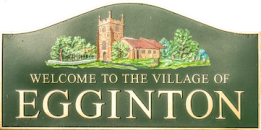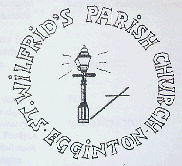
In early times churches were designed not only for the Glory of God but also as a refuge in times of invasion, fire, flood and tempest and as a meeting place for celebrations for parishioners before the days of village halls. The tower was a lookout and a vantage point for archers to repel attackers. Hence churches were usually built of stone whilst the villagers lived in timber framed mud, wattle and thatched homes. The churchyard served for fairs and dances as well as providing a burial ground. Yew trees were planted to provide bows for village archers and the stones of the church were used for sharpening axes and swords as well as sickles and arrowheads.
Evidence can be seen of building work carried out around 1290 to 1300 when the present church was built. It replaced an earlier Norman church, which itself probably replaced an older Saxon church on the same site.
Note the priest’s door in the south wall of the chancel. The chancel was the responsibility or the rector, who had his own entrance convenient for the rectory – the adjoining house to the south-west of the churchyard.

On the outside of the South wall of the chancel is a medieval scratch dial, or Mass dial as they are sometimes called. This is scratched on red sandstone about 9ft to the east of the priest’s door and 5ft above ground level. Such dials are thought to have been in use between the Norman Conquest and the coming of mechanical clocks in the thirteenth century.
In medieval church design, aisles were added to the nave not only to accommodate larger congregations but to provide additional altars dedicated to the Virgin Mary (Lady Chapels) or other saints and to allow more scope for processions. The altars were frequently removed during the Reformation as they were alleged to encourage ‘idolatory’ and superstition. St Wilfrid’s has two substantial aisles, which will at some time have had their own altars.

Note the small wooden shelf on the wall of the North aisle. It was placed there by the charity of Francis Bugbury, who died in 1729. He had willed that twelve penny loaves should be provided for twelve of the needy every Lord’s Day for ever. Loaves continued to be placed on this shelf for the needy until bread rationing was imposed shortly after the outbreak of World War 2. The bequest board is at the back of the church and in need of urgent repair.
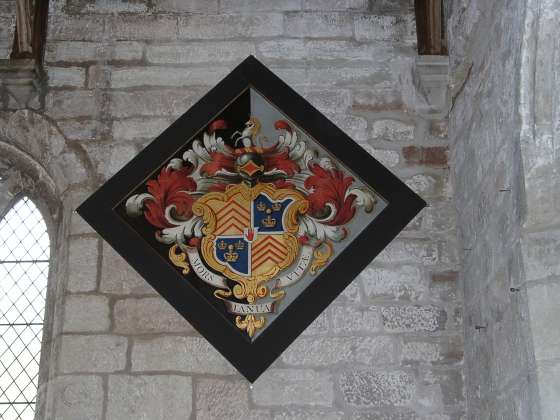
Also high on the wall of the North aisle is a hatchment bearing the arms of the Every family. Hatchments were introduced in the latter half of the 17th century when the tradition was for the hatchment to be displayed over the front door of the house of a deceased person, whose arms it portrayed and remained there until the funeral. At which point it would be processed around the community and then hung on the wall of the nave aisle until a tomb or monument was erected. Fortunately for us, many of these hatchments were not removed after the tomb was made. The background colour indicates whether the hatchment is for the husband or the wife. When looking at the hatchment, if the left side is black and the right side is white, it denotes the death of the husband. Alternatively if the right side is black and the left side is white, it denotes the death of the wife. In this case note the left side is black and with the ‘red hand erect’, denoting a Baronet of England.

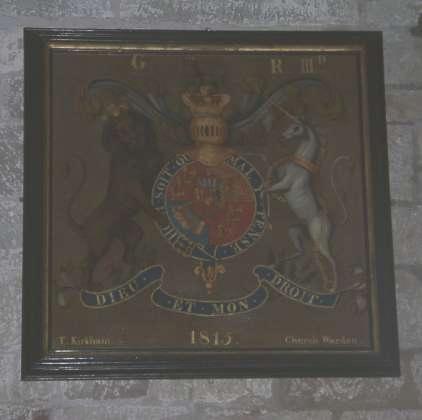
Over the North door are the Royal Arms dated 1815, the year of Waterloo. A Mr Stanley was paid £10.17.6 for it.
The glass of the north window of the sanctuary depicts a fine Nativity scene by the famous Victorian stained glass designer Charles Kempe (1837-1907). The clarity and detail of the design emphasises Kempe’s determination, after realising that his speech impediment would prevent him from taking holy orders, that “if he was not permitted to minister in the Sanctuary he would use his talents to adorn it”.

On the West wall is a long case containing the pastoral staff, pectoral cross and ring of Bishop Every, who was Anglican Bishop of South America and the Falkland Islands from 1910 until his retirement in 1937. He then returned to Egginton as rector until his death in 1941. Also in the case are a clarinet and flute, which used to provide the church music, both of a type used in the 18th century. A bassoon and a violoncello used to complete the quartet.

The South aisle has two low recesses, one of which is empty and the other has a defaced figure in red sandstone much perished. Dr Cox writing in his Derbyshire Churches in 1879, suggests this is of Elizabeth, co-heiress of the Staffords, who had married William Tymore. Later Dr Cox decided the effigy was of a male civilian, not a woman, and this has been confirmed by authorities of medieval dress, who indicate a date of c1330. Of particular interest is that he holds not a book or shield, but a flat-topped ‘heart casket’ and hence this monument marks a ‘heart burial’. The heart could remain, preserved in a lead casket beneath the effigy, assuming the effigy is in its original position. This seems likely, given the fourteenth century dating of the South Aisle. The majority of heart monuments are found in the second half of the thirteenth century, before Pope Boniface VIII outlawed the tradition of a divided burial. Consequently there is a marked reduction in the number of documented cases of heart and entrail burials in the early-fourteenth century. So Egginton’s monument is somewhat of a rarity and considered to be of at least regional importance. No certain reference has been found to identify the man memorialised. Other Derbyshire examples of heart burials are at Barton Blount, Hartington, two effigies at Sudbury and an entrail monument at Ticknall.
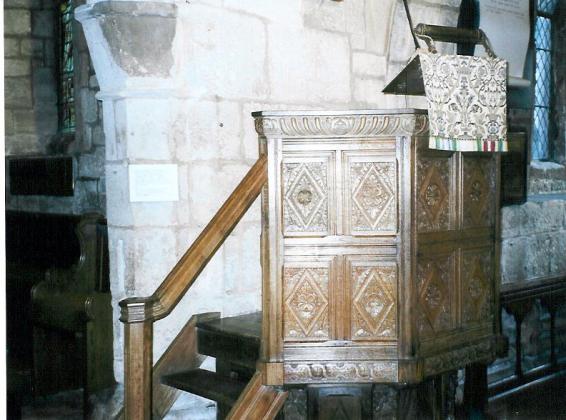
At the entrance to the chancel is the beautiful panelled pulpit given by Sir Edward and Lady Every (11 Bart) on the occasion of their Silver Wedding in 1934. The ancient Tudor oak coming from the old Egginton Hall, badly damaged by fire in 1736. That timber may well been growing at around the same time as our present church was built.
In medieval times the chancel or sanctuary, which contained the high altar, was reserved for the priest and his assistants and the nave for the congregation. The two were separated by a screen of carved stone or woodwork with locked doors. Above the screen was the rood beam upon was set the Rood – the figure of Christ on the cross. Great numbers of these were destroyed during the Reformation as must have happened at Egginton. The chancel arch bears the notches of both screen and rood beam – the latter not filled in with stone.
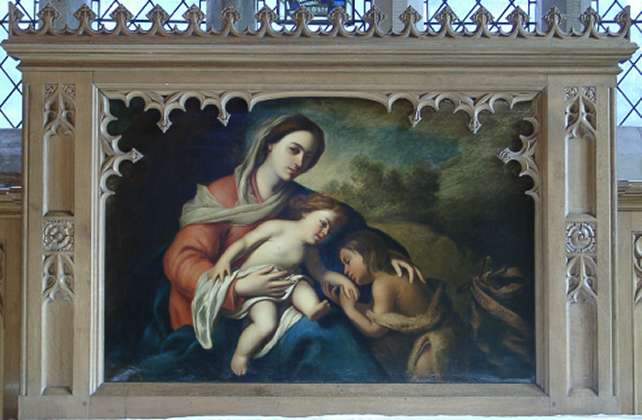
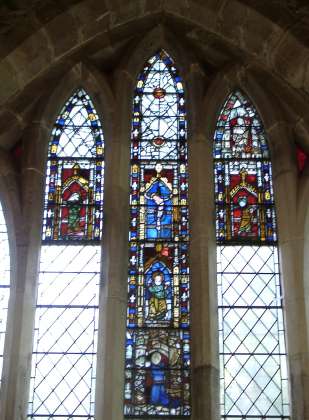
The East window has very interesting old stained glass, thought to date from the 14th century. The high altar has a pleasant oak reredos given by Mr Mosley of Calke, which includes a picture of the Virgin and infant Christ with the young St John the Baptist – after Murillo. It was gifted by Joseph Leigh of Belmont, Cheshire in 1833.

There are several fine memorials including that of Sir Simon Every (1st Bart) and his wife Anne, daughter of Sir Henry Leigh. Also of William Newton of St. James’s London, merchant, giving £2,000 at 3% to the poor of his native parish in 1820 and Francis Bugbury 1729 (of the 12 penny loaves).
In the base of the tower is a delightful set of water colours of Egginton church painted by Miss Eleanor M Every before the major restoration of 1892, and a Mosley hatchment – all black background.
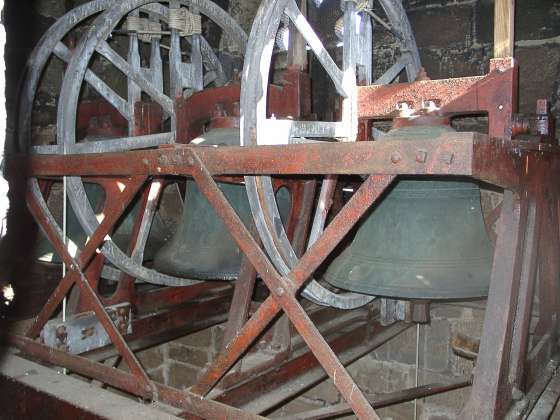
The belfry contains three bells which were re-hung by the parishioners to celebrate Queen Victoria’s Diamond Jubilee in 1897. Two of the earlier bells were sold in 1548 to help pay for repairs to Monks Bridge, “which is so far in decay that the township is not able to amend the same”.
(Acknowledgement is given to the late Jack Henderson, who wrote the excellent booklet “Story of Egginton and St. Wilfrid’s Church”, from which these extracts are taken. You may purchase a copy from the church.)
